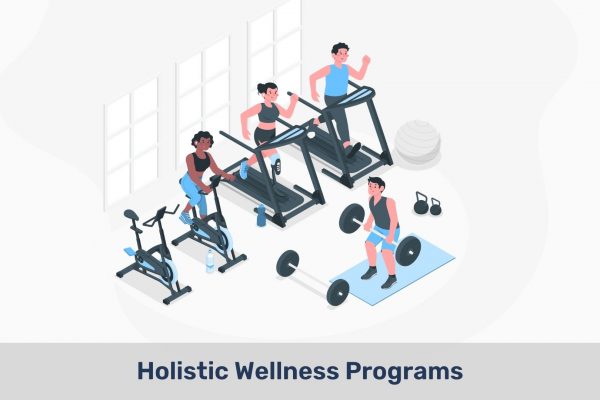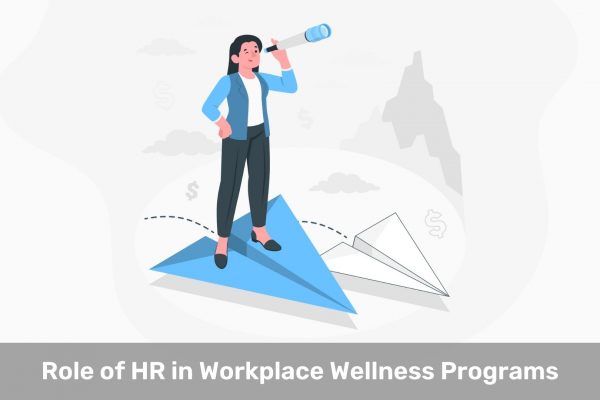Introduction
In recent years, the corporate world has witnessed a significant paradigm shift in its approach to employee health. The rise of sedentary lifestyles and the associated health risks have prompted a reevaluation of workplace priorities. Recognizing the pivotal role that employee health plays in achieving corporate objectives, a growing number of forward-thinking companies are embracing Corporate Fitness Programs as a strategic imperative. Beyond the traditional confines of office spaces and workstations, these programs are instrumental in promoting a culture of holistic wellness, directly impacting employee engagement, satisfaction, and overall performance.
According to a survey conducted by the American Heart Association, an alarming 85% of American office workers spend their days predominantly sitting at desks, leading to a surge in health issues such as obesity, cardiovascular diseases, and mental health concerns.
Amidst this backdrop, Corporate Fitness Programs emerge as a proactive solution to address the physical and mental well-being of employees. A comprehensive study by the International Foundation of Employee Benefit Plans revealed that organizations with well-established fitness initiatives experienced a 14.3% increase in employee productivity, showcasing a direct correlation between fitness and workplace efficacy.
Furthermore, the financial implications of employee health cannot be overstated. The Centers for Disease Control and Prevention estimates that businesses lose approximately $225.8 billion annually in productivity due to absenteeism caused by health-related issues. Corporate Fitness Programs, when strategically implemented, offer a tangible means to reduce absenteeism, healthcare costs, and boost overall organizational performance.
Beyond being a mere employee perk, corporate exercise programs represent a strategic investment in the physical and mental capital that propels an organization toward sustained success.
How does Corporate life become Sedentary?
Corporate life can become sedentary due to a combination of factors inherent in modern office environments and work practices. Here are some key reasons why corporate life tends to be sedentary:
- Many corporate roles involve desk-bound jobs where employees spend extended periods sitting at a computer. Continuous sitting can lead to a sedentary lifestyle, contributing to various health issues.
- With the prevalence of computers, smartphones, and other devices, employees may spend a significant portion of their workday engaged in sedentary activities.
- Frequent meetings may involve long periods of sitting, limiting opportunities for physical activity during the workday.
- Lack of on-site fitness facilities, wellness programs, or policies supporting movement can contribute to inactivity.
- Heavy workloads and tight deadlines may lead employees to prioritize work tasks over physical activity. The perception of limited time can result in individuals neglecting opportunities for movement.
- Employees may have limited breaks or feel pressure to skip breaks to meet work demands. This can reduce opportunities for short walks or other forms of physical activity during the workday.
- Long commutes, whether by car or public transportation, contribute to the overall sedentary time in a person’s day.
- Poorly designed workstations may contribute to discomfort or musculoskeletal issues, discouraging employees from moving around. A lack of ergonomic furniture can contribute to a more sedentary work environment.
How does an inactive lifestyle affect employees?
An inactive lifestyle can have significant adverse effects on employees, impacting both their physical health and overall well-being. Here are several ways in which an inactive lifestyle can affect employees:
a) Decreased Physical Health:
-
- Obesity: Lack of physical activity is a key contributor to obesity. Sedentary behavior, combined with poor dietary habits, can lead to weight gain and related health issues.
- Cardiovascular Problems: Inactivity is associated with an increased risk of heart disease and other cardiovascular conditions. Regular physical activity helps maintain heart health and reduces the risk of developing such problems.
b) Reduced Mental Health:
-
- Stress and Anxiety: Physical activity is known to reduce stress and anxiety levels by triggering the release of endorphins, the body’s natural mood lifters. Inactivity may contribute to heightened stress and anxiety.
- Depression: Sedentary behavior has been linked to an increased risk of depression. Physical activity has antidepressant effects and can positively impact mental health.
c) Reduced Productivity at work
-
- Low Energy and Focus: Inactive employees may experience lower energy levels and reduced ability to focus, leading to decreased productivity in the workplace.
d) Increased Risk of Chronic Diseases:
-
- Type 2 Diabetes: Physical inactivity is a major risk factor for developing type 2 diabetes. Regular exercise helps regulate blood sugar levels and reduces the risk of insulin resistance.
- Certain Cancers: An inactive lifestyle has been linked to an increased risk of certain cancers, including colorectal and breast cancer.
e) Weakened Immune System:
-
- Susceptibility to Illness: Lack of physical activity is associated with a weakened immune system, making individuals more susceptible to illnesses and infections.
f) Poor Sleep Quality:
-
- Insomnia and Sleep Disorders: Sedentary behavior can contribute to poor sleep quality and the development of sleep disorders. Regular exercise is known to promote better sleep.
What is a Corporate Fitness Program?

A Corporate Fitness Program is a structured initiative implemented by businesses and organizations to promote the physical health and well-being of their employees. These programs are designed to encourage regular physical activity, improve fitness levels, and address overall wellness, recognizing the interconnectedness between employee health and workplace productivity.
Corporate Fitness Programs typically encompass a range of activities, services, and resources aimed at promoting a culture of health within the workplace. These initiatives can include on-site fitness facilities, organized group exercise classes, wellness workshops, health screenings, nutritional counseling, and incentives to encourage employees to adopt and maintain healthy lifestyles.
The objectives of these programs extend beyond the immediate health benefits for individual employees. Businesses recognize that a healthier workforce contributes to increased productivity, reduced absenteeism, lower healthcare costs, and enhanced employee morale. These programs also play a role in creating a positive organizational culture, promoting teamwork, and improving overall job satisfaction.
Corporate Exercise Programs are adaptable and can be tailored to meet the specific needs and preferences of diverse workforces. Whether through subsidized gym memberships, wellness challenges, or ergonomic workplace designs, organizations are increasingly investing in these programs as a strategic tool to attract and retain top talent, mitigate health-related risks, and ultimately contribute to the long-term success of the business.
What does a good corporate exercise program look like?
A good corporate exercise program is comprehensive, engaging, and tailored to meet the specific needs and preferences of employees. Here are key characteristics that define a successful corporate exercise program:
-
- Diverse Exercise Modalities: A well-rounded program includes a variety of exercise options, such as cardiovascular activities, strength training, flexibility exercises, and mind-body practices. This ensures that participants can choose activities that align with their fitness levels and preferences.
-
- Accessibility and Inclusivity: The program should be accessible to employees of all fitness levels and abilities. This includes accommodating individuals with different physical capabilities, offering modified exercises, and providing inclusive facilities or virtual options for remote employees.
-
- Professional Guidance: Employing certified fitness professionals or partnering with reputable fitness experts ensures that employees receive proper guidance and support. This may include personalized fitness assessments, workout plans, and expert-led exercise sessions.
-
- Integration into the Workday: Recognizing the time constraints of a corporate environment, a successful program seamlessly integrates exercise into the workday. This can involve short, effective workouts, lunchtime fitness classes, or strategically scheduled breaks for physical activity.
-
- Incentives and Recognition: Incorporating incentives, rewards, or recognition for participation and achievements can boost motivation. This might include wellness challenges, fitness competitions, or acknowledgment of milestones reached.
-
- Flexibility and Adaptability: Recognizing that individuals have different schedules and preferences, a successful program is flexible and adaptable. This might include offering both in-person and virtual options, accommodating shift work, and providing resources for home-based workouts.
-
- Leadership Support and Company Culture: A good corporate exercise program has the backing of leadership and is integrated into the company’s culture. When leadership actively supports and participates in the program, it sends a powerful message about the organization’s commitment to employee well-being.
Benefits Of Corporate Fitness Programs
Corporate fitness programs offer a wide range of benefits that positively impact both employees and the organization as a whole.
- Regular participation in corporate exercise programs promotes physical well-being by reducing the risk of chronic diseases such as cardiovascular issues, diabetes, and obesity. Employees who engage in regular physical activity tend to experience improved overall health.
- Exercise is known to have positive effects on mental health, reducing stress, anxiety, and depression. Corporate fitness programs contribute to a healthier and more resilient workforce by providing an outlet for stress relief and promoting better mental well-being.
- Employees who engage in fitness programs often experience enhanced productivity, focus, and creativity in their work.
- Employees who maintain a healthy lifestyle through participation in fitness programs are less likely to fall ill or require sick leave.
- Employees are more likely to stay with a company that demonstrates a commitment to their holistic well-being.
- Companies with healthy and active employees may experience a reduction in healthcare costs over time.
Corporate Fitness Programs Ideas
These exercise programs come in various forms and can be tailored to suit the specific needs and preferences of different organizations.
1. On-Site Fitness Centers

On-site fitness centers are dedicated exercise facilities located within or near the workplace, providing employees with convenient access to fitness equipment and exercise opportunities. These centers are designed to promote physical activity, improve employee well-being, and create a supportive environment for maintaining a healthy lifestyle.
-
- Gym Equipment: On-site fitness centers typically offer a range of exercise equipment, including cardio machines (such as treadmills, elliptical trainers, and stationary bikes), strength training machines, and free weights. The variety allows employees to engage in a well-rounded fitness routine.
-
- Fitness Classes: Some on-site fitness centers may also host group exercise classes, led by certified instructors. Classes can include activities like yoga, pilates, group cycling, or circuit training. Group classes promote social interaction and create a sense of community among employees.
-
- Flexible Hours: To accommodate various work schedules, on-site fitness centers may operate during flexible hours, including early mornings, evenings, and weekends. This flexibility ensures that employees have the opportunity to engage in physical activity at times that suit their individual preferences.
-
- Professional Guidance: Some on-site fitness centers employ fitness professionals or partner with external trainers to provide guidance, support, and expertise. This can include personalized workout plans, fitness assessments, and assistance in using equipment safely and effectively.
Also Read: Desk Workout Equipment
2. Group Exercise Classes

Group exercise classes are a popular component of corporate fitness programs that involve employees participating in structured fitness activities led by an instructor. These classes are designed to promote physical activity, improve fitness levels, and team playing among participants.
- Variety of Activities: Group exercise classes offer a diverse range of activities to cater to different fitness levels and preferences. Examples include aerobics, dance workouts, yoga, Pilates, spinning (indoor cycling), and high-intensity interval training (HIIT).
- Instructor-Led Sessions: Trained fitness instructors lead group exercise classes, providing guidance on proper technique, motivation, and ensuring a safe workout environment. Instructors may tailor the intensity of the class to accommodate participants with varying fitness levels.
- Scheduled Classes: Classes are typically scheduled at specific times during the workday, either before or after office hours or during lunch breaks. Having a set schedule helps employees plan their participation in advance.
- On-Site and Off-Site Options: Depending on the company’s resources, group exercise classes can be conducted on-site in designated fitness areas or off-site at local fitness facilities. Remote or distributed teams may be accommodated with virtual options.
3. Fitness Challenges

Employees are motivated and engaged in adopting healthier lifestyles through regular physical activity by structured fitness challenges. These challenges typically involve setting specific fitness goals, often with a competitive or collaborative aspect, to encourage participants to push their boundaries and make positive changes.
-
- Objective: To support employees in achieving and maintaining a healthy weight by promoting regular exercise and proper nutrition.
- Format: Participants set weight loss goals and engage in activities like regular workouts, meal planning, and tracking progress.
- Duration: Typically runs for a specified period, such as a 6-week or 8-week challenge.
-
- Objective: To encourage employees to increase daily physical activity levels by tracking and comparing step counts.
- Format: Participants use pedometers or fitness trackers to monitor steps, engaging in friendly competition or collaborative efforts.
- Duration: Can range from a week-long challenge to ongoing step competitions.
Fitness Competition Events:
-
- Objective: To promote teamwork, camaraderie, and healthy competition among employees.
- Format: Organizing events like corporate sports leagues, relay races, or obstacle course challenges.
- Duration: Can be a one-time event or part of a broader fitness program.
-
- Objective: To provide flexibility for remote or distributed teams to participate in fitness activities.
- Format: Virtual fitness challenges leverage online platforms for tracking and engagement, such as virtual races, online fitness classes, or team challenges.
- Duration: Flexible, with ongoing virtual engagement opportunities.
4. Corporate Sports Leagues

Companies or specific industries/locations organize Corporate Sports Leagues for sports competitions within their ranks. These leagues provide employees with the opportunity to engage in team sports, promoting teamwork, camaraderie, and a sense of community within the workplace. Corporate Sports Leagues can take various forms, and the choice of sports often depends on the interests and preferences of the participants.
-
- Sports Offered: The choice of sports can vary based on the interests and facilities available. Common options include soccer, basketball, volleyball, softball, and even less traditional sports like kickball or ultimate frisbee. Companies may choose sports that suit the skill levels and preferences of their employees.
-
- Competitive Spirit: Corporate Sports Leagues provide a platform for friendly competition among employees. The competitive element is often lighthearted, emphasizing sportsmanship, fair play, and mutual respect. The goal is to create an enjoyable and positive experience for all participants.
-
- Regular Season and Playoffs: Similar to professional sports leagues, corporate leagues typically have a structured schedule, including a regular season followed by playoffs. This format adds excitement and engagement as teams compete for top positions and potentially move on to championship games.
-
- Intracompany and Intercompany Leagues: Within a single company, different departments or teams can organize leagues and compete against each other. Multiple companies within an industry or region can form leagues. Inter-company leagues provide networking opportunities and a chance for employees to interact with peers from other organizations.
5. Health Screenings and Assessments

Health screenings and assessments within a corporate fitness program involve systematic evaluations of employees’ health parameters to identify potential risk factors, promote awareness, and guide personalized wellness strategies. These screenings provide valuable data that can inform individuals about their current health status and help organizations tailor fitness and wellness initiatives to address specific needs.
- Biometric Screenings: Biometric screenings typically involve measurements of key health indicators such as blood pressure, cholesterol levels, blood glucose levels, and body mass index (BMI). These screenings provide insights into cardiovascular health, diabetes risk, and overall metabolic well-being.
- Health Risk Assessments (HRAs): Health risk assessments are surveys or questionnaires that employees complete to gather information about their lifestyle, medical history, and current health behaviors. The data collected helps identify potential risk factors for chronic diseases and guides individuals toward appropriate interventions.
- Fitness Assessments: Fitness assessments evaluate an individual’s physical fitness levels, including cardiovascular endurance, muscular strength, flexibility, and body composition. These assessments may involve exercises, measurements, and tests to gauge overall fitness and identify areas for improvement.
- Wellness Surveys: Wellness surveys are tools used to gather information about employees’ perceptions of their overall well-being. They may cover topics such as stress levels, sleep quality, nutrition habits, and mental health. Survey results can inform the design of wellness programs and resources.
6. Flexible Fitness Breaks

Flexible Fitness Breaks refer to a workplace initiative that encourages employees to incorporate short, flexible bursts of physical activity into their daily routines. The aim is to break up prolonged periods of sitting and promote movement throughout the workday. Individual schedules and preferences can adapt to these breaks. It allows employees to engage in quick exercises or activities that suit their fitness levels and comfort.
Key features of Flexible Fitness Breaks include:
- Adaptability: Employees are encouraged to choose activities that fit their needs and preferences. The emphasis is on flexibility to accommodate various fitness levels and personal preferences. It can be stretching exercises, brief walks, or quick workouts.
- Short Duration: The breaks are intentionally short to minimize disruption to work tasks. They typically range from a few minutes to around 10 minutes. It gives feasibility to employees to integrate into their schedules without feeling overwhelmed.
- Variety of Activities: Flexible Fitness Breaks can encompass a variety of activities, such as stretching exercises, bodyweight workouts, yoga poses, or even simple desk exercises. The goal is to provide options that cater to different fitness interests and levels.
- Encouragement for Movement: The primary purpose is to combat sedentary behavior by encouraging employees to stand, stretch, or move around periodically. This is particularly important for those who have desk-bound jobs and might spend extended periods sitting.
Conclusion
Corporate Fitness Programs have emerged as indispensable tools for organizations aiming to create a healthier and more productive workforce. The multifaceted benefits, ranging from improved physical and mental health to enhanced team dynamics, underscore the strategic importance of prioritizing employee well-being in the corporate landscape. Woliba play a pivotal role in providing tailored solutions to meet the evolving needs of corporate wellness programs.
Woliba stands out as a dynamic and versatile platform, offering a range of features to support the health and fitness goals of employees. Through personalized fitness plans, wellness challenges, and a variety of exercise options, Woliba facilitates a holistic approach to employee well-being.
Woliba’s modules aligns with the core principles of successful corporate fitness programs. Woliba contributes to the creation of a workplace environment that supports each individual’s journey towards a healthier and more active lifestyle.
Contact us today to explore how Woliba can be the catalyst for positive change in your organization’s well-being landscape.





